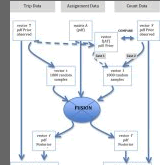
 |
Methods
for estimating origin-destination (OD) trip matrices based on flow
counts on transport network links have been an established aspect
of transport modelling since the late 1980s and are widely applied.
Motivated by interests in maximising the exploitation of data increasingly
available from instrumented highways, as well ensuring that OD matrices
are estimated in the most appropriate way, the UK Highways Agency
(HA) commissioned this research project aimed at enhancing the development
of OD matrices. The project was undertaken by Hyder Consultancy and
its project partners, including a prominent role for Minnerva. The
study focused on the 'fusion' of count data with prior matrix data,
but the researched methodology was designed to support a wider range
of data sources, including from ANPR and GPS-based instruments
While some theoretical alternatives exist, current matrix estimation methods may be seen as variations on a common theme, which uses an 'objective function' to guide the adjustment of a prior trip matrix to match information on input observed flows. The translation from flows to matrix cell values involves information on vehicle (or passenger) routeings, which is taken from network modelling sources. The project, known as 'OD Data Fusion', developed a generic simulation-based methodology for investigating the choice of objective function, such as Maximum Likelihood, Maximum Entropy, or Generalised Least Squares, and the use and settings of weightings accorded to different sets of data to account for their reliability. The methodology was studied using sets of synthetic data for which a ‘true’ OD matrix was known, which is never possible with real data. Real data was taken from two recent HA network modelling projects, corresponding to 'small' and 'large' scales to assess the methodology in relation to actual applications. A feature of the methodology, which was implemented using MATLAB software, was the integral consideration of variability described by probability distribution functions (pdfs), rather than simple mean values that are typically used. The study explored different levels of variability on the results using assumptions involving Poisson and Normal distributions, but part of the study also analysed extensive sets of traffic count data and used Bayesian Monte Carlo Markov Chain simulation modelling to implement a hierarchical mixture model of pdfs to reflect more properly the distributions observed in actual data. The methodology both exploited information about the variability of input data (described using pdfs) and provided equivalent output information on the variability for its outputs, whether in terms of matrix cells or flows on links Contact: Miles Logie |

|
|
